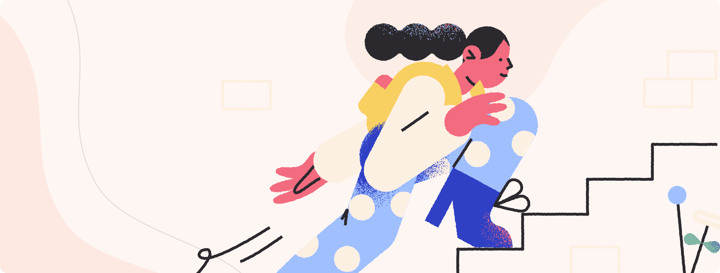Getting students excited about reading isn’t always easy—especially for emerging readers. But the right motivation can change that. Reading challenges turn reading into a fun, goal-oriented experience that sparks a love for books while strengthening literacy skills. For over a century, these programs have fostered community literacy and built reading cultures across all grade levels.
Today, libraries and schools can utilize software tools like Beanstack to quickly organize reading challenges and provide valuable data supporting community-wide efforts to boost literacy rates. These reading challenges can be set up during the school year and the summer months.
In this post, we’ll explain a reading challenge, offer a little history, and then discuss how the programs have changed over time. Ready to get reading?
Jump to a section:
- What is a reading challenge?
- Choosing your reading mission
- Reading challenges move from paper to digital
- Using data to understand your readers
- Community literacy in the digital age
What Is a Reading Challenge?
Many of us were introduced to reading challenges through our local libraries during summer vacations, but the importance of these programs goes much deeper than the fun worksheets we remember checking off as kids. Reading challenges offer a set of shared goals for a community of readers over a defined period. They typically target specific populations – for example, elementary school students in a local school district – and provide goals and incentives to encourage the target audience to track their reading. Unlike a reading log, which focuses on individual growth, reading challenges center on community – often, the challenge goals are collaborative and include individual and group milestones. Reading challenges can include different mediums, including graphic novels, audiobooks, and traditional books.
Ultimately, the goal of any reading challenge is threefold: to build a culture of reading in a community, increase book circulation, and offer insight into the reading habits of students and library patrons. For school administrators and teachers, these insights can provide powerful data to support library funding and understand how their students measure up to national benchmarks.
Choosing Your Reading Mission
When librarian Linda Eastman created the first reading challenge in 1895, her Cleveland Children’s Library League sparked a movement, inspiring summer reading programs in public library systems around the world. Though Eastman’s focus was on promoting student reading during the summer months, reading challenges have since evolved to encompass a wide variety of goals, timeframes, and themes.
Today, reading challenges often focus on encouraging students to move out of their reading “comfort zones” to sample diverse authors, titles, and themes. To that end, Beanstack has developed reading competitions for observances like Martin Luther King Jr. Day and Women's History Month. Unlike summer reading challenges, where the focus is on fighting the summer slide, themed reading challenges encourage participants to consider new ideas and experiences and engage in community dialogue, regardless of the genre category.
If you’re creating a reading challenge, remember that it can be as specific or sweeping as you like, but it should have a defined start and end date, an attainable yet optimistic goal, and clear milestones for readers to measure their progress. For instance, you could also run a longer reading competition for schools during other times of the year, such as with a winter reading challenge.
Reading Challenges Move From Paper Logs to Digital Reading Logs
Reading challenges work on the principle that the more students practice reading, the more likely they are to reach national benchmarks—and incentivizing students makes it all the more likely. Today, technology has allowed reading programs to move online, leaving behind paper tracking sheets and making it easier for parents to get involved, students to connect with one another, and educators to track progress through reading goals.
Broward County Public Schools (BCPS) in Broward County, Florida, is a case in point. Instructional Facilitator Lourdes Meyer and Curriculum Supervisors Neena Grosvenor and Lynne Oakvick developed an ongoing paper reading program, Read Across Broward, to support literacy across the district. However, after studying reading proficiency among the district’s third graders, the team realized that their existing program wasn’t providing the support their students needed to thrive. They started a coalition called the Broward Campaign for Grade-Level Reading and made it their mission to find innovative solutions to increase participation in their independent reading program. Beanstack’s digital app was the solution they were searching for.
Using Beanstack, BCPS ditched its cumbersome paper-based program, moving Read Across Broward into the digital realm. To ensure teachers and librarians felt supported, the team organized an official Beanstack launch, including technical training and insight into Beanstack’s data analytics platform.
The program was wildly successful, with more than 350,000 books logged in seven months. At the top-performing elementary schools, as many as 92% of students are now using Beanstack. As they move forward, BCPS is looking to use the ongoing excitement about Beanstack to support other school-created challenges, including a Minutes Read challenge and Makerspace challenges.
Using Data to Understand Your Readers
With the ability to track readers’ choices and habits, online reading challenges also offer school districts an incredible opportunity to get to know their readers. Understanding students’ reading habits and where their interests lie can help educators target reading initiatives to support students the way they prefer to read, while the data can help identify struggling students who might need more help. This is where Beanstack shines.
For administrators, Beanstack provides an analytics dashboard to understand student reading habits and demonstrate school libraries' role in academic success. The data also helps administrators and teachers determine how their students match up to national standards. For librarians, Beanstack offers insight into the books students are reading, which guides purchasing decisions and activities. For students, Beanstack turns reading into a game, with a record of books read, interactive activities, the opportunity to write reviews their peers can read, and badges for reading streaks as prizes.
Community Literacy in the Digital Age
When you know your readers, you can fully support them when they need assistance – whether you are an administrator fighting for library funding or a parent tracking your child’s reading habits. Fostering a culture of reading is a community effort, and digital reading challenges provide the structure and motivation students need, along with the data to support long-term student success. Whether it is a single-school building or district-wide reading challenge, community literacy will grow, test scores will increase, and students will develop a lifelong love of reading.
Ready to kick off a reading challenge at your library or school? Contact us today for a personalized demo of Beanstack and learn about our library of ready-made templates for all ages, children and teens alike.





